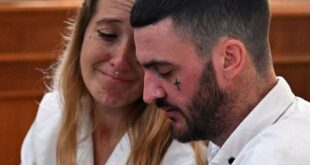It was the royal arrival that should have been the most wonderful news for the whole country.
On June 10, 1688, after 15 years of miscarriages, stillbirths and deaths in infancy, Queen Mary of Modena gave birth to a boy.
In little James Stuart, the Catholic King James II finally had the male heir he had so desperately sought.
But, as the third episode of new Mail podcast Queens, Kings and Dastardly Things reveals, the nation, and the King’s own (protestant) daughters from his first marriage, were sceptical.
Mail columnist and royal biographer Robert Hardman and his co-host, historian Kate Williams, explore the scandalous ‘warming pan’ claim.
Its proponents alleged that a baby was smuggled into Queen Mary’s bedchamber so it could be passed off as the legitimate heir.
On June 10, 1688, after 15 years of miscarriages, stillbirths and deaths in infancy, Queen Mary of Modena gave birth to a boy. In little James Stuart, the Catholic King James II finally had the male heir he had so desperately sought

King James II gave up the throne in 1688 after William of Orange sent an invasion force to Britain
King James’s younger daughter, Princess Anne, wrote to her sister, Princess Mary, to say that she thought their step-mother was wearing a ‘false belly’.
Anne, who Mr Hardman and Professor Williams jokingly refer to as ‘Miss Marple’, had intended to observe the birth herself but was away in London when the Queen was claimed to have gone into labour.
She angrily told her sister of her ‘concern and vexation, for I shall never now be satisfied whether the child be true or false.’
Further suspicion came with the fact that the witnesses to the birth claimed they had turned their backs to protect the Queen’s privacy and so had not seen anything.
Professor Williams says in the programme: ‘The public are ready to believe that the baby isn’t the King’s, that either the entire pregnancy was a lie, fake news, fake bump, the whole thing faked, or that the baby had died in childbirth.’
Scepticism stemmed from the fact that Queen Mary had had such bad luck up until then with stillbirths and the deaths of her children in infancy.
Equally, there were rumours that King James – who had converted to Catholicism in 1669 – was impotent due to a bout of venereal disease.


King James’ daughters from his first marriage, Princess Anne and Princess Mary – both future Queens – believed that their father’s heir was not legitimate. Above: Anne (left) and Mary


The podcast is presented by Mail columnist and royal biographer Robert Hardman and historian Professor Kate Williams
Mr Hardman suggests in the podcast that the rumours about the Queen’s pregnancy stemmed from the desire to ensure the Crown was passed to a Protestant successor.
‘You can imagine that for a number of people, not least the king’s daughters, they’d much rather the king and Mary of Modena remain childless, and the crown passes directly to his Protestant daughters by his previous marriage,’ he says.
‘And that’s probably why some of the rumors about the queen’s pregnancy start to circulate.’
Professor Williams adds: ‘The public reacts totally on the side of this conspiracy.
‘Cartoons are drawn, articles are written, pamphlets all about the warming pan baby and they actually start producing maps of the palace showing the quickest route to sneak a baby inside the warming pan to the queen who is at that point pretending to give birth, who’s moving her fake bump.’
The saga led to the rule that the home secretary had to be present at every royal birth.
The tradition continued until the birth of Princess Alexandra – the cousin of the late Queen Elizabeth II – in 1936.
After the birth of Queen Elizabeth a decade earlier, home secretary Sir William Joynson-Hicks conveyed the news by special messenger to the Lord Mayor of London, despite the fact that the government was embroiled in a row with coal miners.
Regardless of the true status of James Stuart’s lineage, his father had run out of time.
William of Orange, the King’s fiercely Protestant nephew and – as the husband of Princess Mary – son-in-law, was about to invade.
The birth of baby James had given William the excuse he needed to act.
The fiercely protestant ruler of the republican Netherlands arrived on British shores with an invasion force in November 1688.
While his father Charles I had fought and lost in the bloody Civil War, James II chose to flee in what became known as the Glorious Revolution.
After being smuggled to France, he lived there in exile for the rest of his life.

William of Orange, the King’s fiercely Protestant nephew and – as the husband of Princess Mary – son-in-law invaded Britain in 1688
William and his wife Mary – James II’s daughter – were crowned as joint monarchs.
Their reign together lasted until Mary’s death in 1895, after which William continued as King until he passed away in 1702.
The throne then went to Anne, the daughter of James II who had been so suspicious about her half-brother’s birth.
As for the Catholic James Stuart, he was barred from becoming monarch by the Act of Settlement 1701.
When his father died that year, James claimed the thrones of England, Ireland and Scotland with the backing of France.
But a landing in Scotland in 1708 failed to succeed, as did further invasion efforts in 1715 and 1719.
The last serious effort to restore the House of Stuart came with the 1745 Rising, when his son Charles Edward Stuart – better known as Bonnie Prince Charles – tried to seize the throne.
Listen to the latest episode of Queens, Kings, and Dastardly Things here.
Robert Hardman is the author of books including Queen of Our Times: The Life of Elizabeth II and Charles III: New King. New Court. The Inside Story.
Professor Kate Williams is the author of the recent book The Royal Palaces: Secrets and Scandals, along with many other works.
Source link




